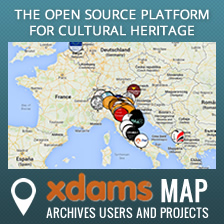August 2016, Last Update – LIDO Description Standard
The platform is composed by descriptive subsets, arranged by autonomous XML databases, located in dedicated directories of the “database server”. Typically the structure is organized in the following way:
- a data base that surveys all the funds managed by a single account and enables to describe their preliminary structure, according to the rules of multi-level description and of the data (database/informational) structure required by the ISAD(G) standard;
- a multiplicity of databases for the archival description of single documental or multi-media funds, according to the ISAD(G) standard;
- authority files, common to all the documental databases, relative to people’s names and names of bodies (entity/authority) according to the ISAAR-CPF standard.
The system provides a “multi-fund” allocation, in which a determined structure can be associated to different archives of heterogeneous nature: historical, photographic, audio-visual etc.
All the descriptive metadata are stored within xDams in native XML databases.
XML is the format that ensures the long-term gathering of the descriptive information, and its reuse in different context, also outside of xDams platform. Furthermore, the advantages to have XML data are two: the first one is that they are immediately interoperable with other harvesting systems; the second one, is that it is more easier importing data from other information systems and platforms.
The data model implemented compliant with the most relevant standard of archival description:
- ISAD(G) , the ICA rules for describing the historical archives;
- ISAAR(CPF) and ISDIAH , the ICA rules for describing archival authority records.
The data models adopted to encode the archival metadata in XML format are:
- EAD , to encode the description of the archival resources
- EAC-CPF , to encode the description of the archival authority records.
The inclusion of the data structure standard EAD and EAC-CPF is a strategic choice, that make possible:
- realising a common data structure, that is helpful to all the archival resources, belonging to different genres or form (such as paper resources, photos, audiovisual material, and so on), in order to merge, within the same elements of description, the same kind of information, even if defined in data content standards of different cultural sectors (such as ISAD(G), FIAF cataloguing rules for the audiovisual material, ICCD cataloguing rules or VRA CCO cataloguing rules for the iconographic documentation and the visual objects);
- to include those data elements not provided in the standard rules, but that are useful for search and recovery. The authority lists, or the specific details of some type of resources not only in paper format, could increase the quality and the chances to access to content information, through fast channels or filters.
In addition to the defined data fields of the archival material, it is possible to implement specific data fields, on the basis of the user needs, insofar compliant with one of the EAD and EAC-CPF data elements set.
The anchoring to a single central authority and the sharing of the descriptive data structure of the content allow an immediate integration of heterogeneous archives, the availability of common indexes and shared search instruments.
The Authority databases purpose is to assure the control and normalization of the data inserted for some of the types of data fields, in order to have the availability of reliable indexes shared within the entire information system, as well as of the complete list of the creators of the different archival funds present in the system









